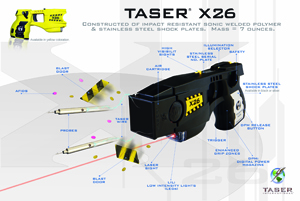
Handguns, expandable batons and pepper spray are some of the hand weapons that Binghamton’s New York State University Police carry. This past June, the agency added the Taser to its everyday arsenal.
The Taser, which incapacitates a person with an electric shock, is an alternative tool ‘to protect the campus in less-than-lethal situations where somebody has to be controlled or restrained,’ said Assistant Chief Bill Dunn of University Police.
Campus police acquired three $1800 X26 Tasers from TASER International Inc. in response to a SUNY-wide report of campus safety after the Virginia Tech shooting. The report, known as Chancellor’s Task Force on Critical Incident Management, recommended that every SUNY overhaul its emergency equipment.
The Taser, which resembles a handgun, is stored in a holster and is equipped with a camera that records when the safety is off. At the flick of a trigger, two probes connected to wires are propelled forward to hit the person at either direct contact or up to 35 feet away. It delivers 50,000 volts ‘ static from a doorknob delivers 35,000 to 100,000 volts ‘ for an initial five-second interval. Officers can then continue to shock the person.
The shock temporarily overrides the nervous system, forcing the person to lose neuromuscular control and the ability to perform coordinated action. The person recovers instantly as soon as the shock ceases.
Officers haven’t fired the Tasers at anyone yet, but did brandish it once, Dunn said.
About 11,500 law enforcement agencies deploy TASER technology, but there have been no reports of overall increasing injury rates to suspects or officers, according to a TASER spokeswoman.
University at Albany is the only other SUNY with Tasers. TASER International could not say how many other campuses use the device, a spokeswoman said.
Twenty-eight of the 35 members of the police force are certified to use the devices, allowing each shift to have certified officers on duty. The officers went through six hours of training this summer, which included getting the full five-second shock themselves.
Investigator Dennis P. Bush, who trained this summer, described the pain of getting shocked as throbbing and all-encompassing. But as soon as the current stops, ‘You’re fine,’ he said. ‘It was no biggie.’
‘We did this with the intention of better understanding what the effects are,’ Dunn said. ‘So when we’re going to use it, it’ll make us sensitive to the appropriate times to use it.’
But while getting stunned hurts, the device is not dependent on pain. The primary purpose is to ‘incapacitate a person to control that person,’ Dunn said.
The Taser is one option police can use when someone is actively defiant ‘ for example, resisting arrest ‘ or to prevent someone from hurting himself or other people. In situations like these, officers could also use manhandling or pepper spray. But outdoors where there is wind or many people, pepper spray may not be the best option, Dunn said.
According to Dunn, officers are held accountable for use of the Tasers. They must follow regulations, like a use-of-force protocol created by Dunn and Article 35 of the New York State Penal Code. The video recorded by the Taser is sequestered in an evidence cabinet ‘ it can be used to incriminate someone and to investigate the officer.
‘We always double-check use of force by officers,’ Dunn said. ‘Whenever an officer has to use force ‘ grappling someone, pepper spray, Taser, baton or even using a handgun ‘ there has to be a report filled out to see if the officer’s force was justified.’


